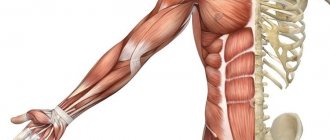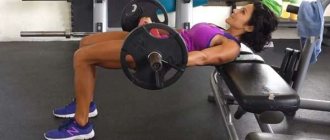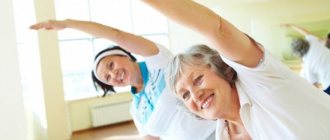To maintain the normal functioning of almost all systems and organs, a person just needs to eat well and lead an active lifestyle. Everyone knows the benefits of walking for men, in particular, for the normal functioning of the genital organs, since sedentary behavior today is the most common cause of sexual disorders in men of all ages.
| Male strength will return if you dilute 7 grams of regular... in a glass of water! Go >>>>> |
| The cheapest way to restore POTENTITY! Only 147 rubles and costs 3 hours! Go >>>>> |
For many men for whom physical activity and sports are contraindicated, walking is an excellent alternative for therapeutic and preventive purposes. Yes, if you look carefully, any sport involves walking, including physical therapy to stimulate potency. To understand the feasibility of this method of increasing sexual activity, it is worth taking a closer look at how walking is beneficial for a man’s body.
Why does a man need to move to stay healthy?
The work of the male genital organs is closely related to the activity of the pelvic organs. The genital organs, like all other organs, require active blood circulation to deliver nutrients and oxygen to them. This is the main and most important feature that allows the organ to be healthy and perform its functions properly.
What happens if blood circulation in a certain area of the body is disrupted? Generally speaking, the work of such an organ slows down, it ceases to cope with its functions. What happens to the genitals?
Two pathological factors can be distinguished:
- With a decrease in blood flow, the activity of the testicles in producing sex hormones and sperm deteriorates;
- Insufficient blood circulation leads to the development of stagnant processes and provokes the development of pathogenic microflora in the pelvic organs.
The level of testosterone, which is largely responsible for both sexual and general health of a man, depends on the work of the testicles, the main endocrine organ of a man for the production of sex hormones.
The unique role of testosterone for a man is well conveyed by this saying: “Testosterone is the king of hormones, the hormone of kings.”
Moderate physical activity in the form of walking improves the production and distribution of testosterone throughout the body, while a sitting position provokes compression of the pelvic organs and impairs blood circulation in this area.
Low physical activity leads to the formation of stagnant processes, which are a risk factor for diseases of the genitourinary system. To maintain local immunity and fight pathogenic microorganisms, normal blood renewal is a necessary condition. Poor circulation allows colonies of pathogenic microorganisms to flourish. It is not for nothing that such a common ailment of male sexual health as prostatitis is often a “well-established” problem.
What's better for burning calories?
Walking and running offer similar health benefits, but running has more calorie-burning benefits compared to walking. A 65kg person burns approximately 15.1 calories per minute while running. In contrast, a person of the same weight burns about 8.7 calories per minute of walking. The number of calories a person burns while walking and running depends on several factors, including:
- body weight
- exercise duration
- activity intensity
Running burns more calories than walking. However, walking can burn the same amount of calories while doing it for longer. However, depending on your goals, walking and running provide the same benefits.
Health Benefits of Walking
Let's outline the benefits you can get if you choose walking as your main source of physical activity.
Walking has the following beneficial properties:
- training of the cardiovascular, respiratory system, skeletal muscles (legs, buttocks, back, abs);
- accelerating metabolism, burning extra calories;
- prevention of congestive processes in the pelvic organs in men;
- improvement of hormonal levels;
- stimulation of the digestive organs;
- stimulation of brain function;
- prevention of cardiovascular diseases, diabetes, musculoskeletal diseases, etc.
Breathing rhythm during exercise
Proper breathing plays an important role during physical activity. Nordic walking is a fairly energy-intensive type of sports activity, in which it is necessary to adjust the respiratory process to the rhythm of movement.
The most acceptable is breathing during movement, when the exhalation is longer than the inhalation, one and a half or two times. In this case, inhale through the nose and exhale through the mouth. Train yourself to inhale for the first 2 steps and exhale for the remaining 3 when practicing Nordic walking.
When, how and how much to go?
Basic principles of healthy walking:
- Moderation. Each of us has our own level of fitness, so any physical activity must be consistent with the general state of health, the presence of diseases, etc. The activity and duration of walking must correspond to the current state of health;
- Gradualism. Gradually increase the main load indicators (speed, distance, time) as you train;
- Regularity. Only regular exercise can have a positive effect on health.
When to go?
In fact, there is no fundamental difference between whether you go out for a walk consciously, just for the sake of walking, or when walking is caused by work and life circumstances. The main thing is to move.
If your line of work requires you to stay active during the day, then you shouldn't even do extra walking. In this case, it is better to pay attention to more active types of anaerobic exercise (running, swimming, outdoor games, etc.), if your health allows it.
If your occupation involves constant sitting, then you need to include walking in your daily routine, even if you exercise 2-3 times a week (for example, go to the gym or pool). And here again, it doesn’t matter whether walking is a conscious step or a forced phenomenon (read on to learn how to increase physical activity in everyday life).
How and how long to walk?
If you don’t want to complicate anything, but get simple advice, then everything is very simple - move more! Walking will help you with this, both at a normal and accelerated pace. You shouldn’t worry about walking technique, counting your pulse, special breathing, and other things if you have a simple desire to improve your health. All these rules will only turn the easy and natural process of walking into a difficult quest.
Here are the principles that must be followed when walking healthy:
- Training walking should consist of 3 stages: warm-up (easy pace) - 2-5 minutes, main part (target walking pace) - 15-20 minutes, cool-down (easy pace) - 2-5 minutes;
- The training should be long enough (from 20 minutes). Since walking is a light physical activity, it takes a long time to complete. Therefore, a short five-minute walk will not have a therapeutic effect;
- Training should be constant (from 3 times a week).
How do lessons end?
When completing a health walk with Nordic walking, you need to systematically slow down the pace of movement and take several deep and long exhalations. Next, you should relax your muscles by performing a few simple stretching exercises:
- Lunges forward, alternately with each leg. The leg standing in front should be bent at the knee, and the other leg should be moved back as far as possible. Perform smooth rocking movements to relax the thigh muscles.
- To stretch your back muscles, you need to place your lower limbs shoulder-width apart and rotate your upper body left and right. Also, you should bend your torso to the sides.
The final relaxation exercises should not last more than 10-15 minutes. After Nordic walking, experts recommend visiting a sauna or taking a hot bath. This will reduce muscle soreness after initial training.
Why do we need simple walking right now?
The development of civilization has made our life more convenient, for which we pay with our health. The advent of computers, the Internet, the spread of motor vehicles, etc. have contributed to the fact that the modern man moves abnormally little. Compare the childhood of children in the early 90s, when the only opportunity to play with friends was active games in the fresh air, and today, when you don’t need to leave the house to play with friends, there would only be a computer and the Internet. This development of events has affected all areas of our lives, from vehicles to sedentary work.
What do we end up with? But as a result, the physical activity of modern people is much less than what it was just a couple of decades ago.
Results of your achievements
- Good mood
- Healthy heart and blood vessels
- Fit look, attractive figure
- Improving quality of life
By changing your own blood flow, you will delay the aging of your body. After all, we all have unachieved goals and unfulfilled obligations. And everyone wants to be young and healthy!
I'm glad if the article is useful to you. Share your knowledge with friends and your successes with us in the comments. See you again on the pages of the Healthy Lifestyle blog!
Basic principles of walking
It is important to learn 3 basic rules:
- The main thing is not to do harm.
The duration and intensity of the walk depends on the state of the body. - Do everything gradually.
You can’t suddenly load the body, you need to gradually increase the time and pace. - Walk regularly.
The main thing is to walk every day. It is acceptable three times a week for half an hour if there is no time.
When should you go?
Try to always move - to work, from work. Is your place of work too far from home? Get off two stops early and walk. Walking in the morning will invigorate you and fill you with energy, but walking in the evening will relieve insomnia and calm the nervous system.
What distance should I choose?
It all depends on your state of health. For an untrained body, a 4-kilometer low-intensity walk will be enough. 20 - 30 minutes will be enough.
To improve your health, try to walk at least 7 km per hour. Such walking is accelerated, training, it perfectly improves the health of the body. It is worth noting that brisk walking is especially useful:
- Reduces excess weight.
- Normalizes blood pressure.
- Stabilizes blood pressure.
- Strengthens muscles, tightens the body.
Attention! It may take several months or years to walk about 10 km without getting tired. Then it will be easier, you will simply maintain your physical fitness with regular, healthy walking.
Indications and contraindications
Walking as a way to improve health is suitable for any age and gender. Everyone chooses the pace, duration, time and route of walks according to how they feel. But there are situations when you need to focus on indications and contraindications.
Indications:
- reduced immunity, lethargy;
- weakness, loss of strength.
Contraindications:
- cardiovascular disorders, arrhythmia, stroke, heart attack;
- pulmonary failure;
- high blood pressure;
- chronic kidney disease, diabetes;
- threat of retinal detachment, glaucoma;
- colds and other acute diseases.
Features of fast walking
Physical activity is important for health, and exercise is recommended for everyone without exception. For those who hate exhausting themselves with heavy loads, brisk walking is perfect. Such workouts will help you stay in shape without much effort; the only important thing is regularity and lack of laziness. Classes do not take much time, but the result can exceed all expectations. After just a week of walking, the desire to lie on the couch will disappear and you will want to progress further in your sporting achievements.
They gradually get used to fast walking, although at first glance anyone can do such training. From high loads at the initial stage, not only will your whole body hurt, but any desire to continue exercising will disappear. In the first days, it is enough to walk literally a couple of kilometers, spending about half an hour. Then, when you feel ease in your movements and breathing becomes easier, you can increase both the load and duration. For clarity: an hour of quality fast walking can replace 15 minutes of jogging .
Walking quickly should be pleasant and not cause any discomfort. This is not a sport where you should work your ass off to show outstanding results. The ideal pace is considered to be one at which breathing is possible through the nose, shortness of breath is not severe, and only slight perspiration appears. The pulse should be kept within 100 beats per minute. If this indicator is lower, then the body will not receive enough load and all efforts will be in vain; if it is higher, there is a chance of seriously harming your health, in particular the cardiovascular system.
Fast walking has its own technique, if followed, the effect of the training will be much higher, and the risk of injury, on the contrary, will be significantly reduced. The step should be taken from heel to toe. To soften the impact of your feet on the hard surface of the ground, you need to consider quality sports shoes. Sneakers must have sufficient cushioning and fit snugly to prevent possible dislocations. The stomach and buttocks are tucked, the back is straight, the shoulders are lowered, the gaze is looking forward. Your arms should be kept bent at the elbows at right angles and actively used while walking.
https://www.youtube.com/watch?v=h7qnCrtm-YY
When developing speed during training, you should not only regulate your heart rate, but also the number of steps per minute. At the initial stage, a speed of up to 90 steps per minute will be considered good, so the body can get used to the load. Those who lead a mostly sedentary lifestyle and move very little should pay particular attention to this. You can then increase the pace to 2 steps per second or 120 steps per minute. Most often, amateurs walk at this speed. If this load is not enough, then you can switch to 140 steps per minute, this pace almost borders on the usual jogging.
Scientists have found that to maintain health, you need to walk about 10 thousand steps (about 8.5 km) a day. The modern lifestyle offers comfortable conditions for covering long distances by public transport or private car, so it is not always possible to walk the required distance on weekdays. To correct this situation, you can purposefully engage in brisk walking every day. In the morning, such a workout will help you wake up and gain energy for the whole day, and in the evening it will be an excellent release and help restore strength.
Walking up the stairs
Walking up the stairs of a high-rise building is the easiest way to improve your well-being. Where to begin? Because one prefers going up and down flights of stairs to entering an elevator.
The more difficult option is to climb past your landing to the top floor, stepping on the steps in a row. The main syndrome of vertical movement is pain in the calf muscles. When the muscles stop reacting painfully, shortness of breath stops, and the heartbeat does not increase, the climb must be made more difficult: stand on the steps on your tiptoes, and later step across the step.
The benefits of walking up the stairs are in the development and strengthening of leg muscles, stabilization of blood pressure, and weight loss. Climbing stairs burns several times more calories than running on a flat surface. The lesson gives a positive effect if it lasts at least 20-35 minutes. But the time frame for reaching this time is individual for everyone.
The benefits of walking are not associated with a specially allocated time. All you need to do is prohibit yourself from using the elevator, ignore the escalator if there are stairs nearby; refuse transport to and from work at reasonable distances.
Walking in place
The peculiarity of this type of walking is that the hips rise as in normal walking, but there is no horizontal movement. Walking in place is a good load on the basic systems of the body. It can be used for general strengthening and to increase endurance. The effect is about the same as normal walking.
“Walking” starts from 5-10 minutes, increases to 60-90 minutes. Speed 50-60 steps/min. corresponds to a 30-minute walk (step is the interval between kicks of the right leg).











